It’s name is Alter, and it’s powered with a neural system that mimics that of humans. The erratic movements and eerie facial expressions it’s making in the video it’s making of its own volition.
This is Alter, an artificial intelligence robot that does not require any human control.
It has a neural network that detects its surroundings, noise, temperature and humidity.
This network is controlled by a central pattern generator that replicates neurons is humans.
These robo-neurons allow it to make erratic movements and facial expressions on its own.
One of Alter’s creators says although it doesn’t look human, “it feels like there’s something alive in there.”
İf looking at Alter doesn’t creep you out at all, hearing it sing will do the trick.
A creepy humanoid robot has been built in Japan with complete control over its limbs and facial expressions.
A creepy humanoid robot has been built in Japan with complete control over its limbs and facial expressions – and just wait until you hear it sing.
‘Alter’ is a humanoid robot designed by scientists in Japan
It has its own neural network that mimics the activity of a human brain
Alter has complete control over its limbs and facial expressions.
Scientists said it was a remarkable achievement to design ‘Alter
Japanese scientists have unveiled a creepy humanoid robot that has complete control over its limb movements and facial expressions.
The robot, ‘Alter’, is embedded with electronic sensors that mimic the neural network of the human brain.
Alter’s arms, head and facial expressions are controlled by these sensors, giving the robot a random pattern of movement eerily similar to a human’s.
Alter can even sing, converting the random movements of its fingers into a haunting synth melody.
Alter is a humanoid robot designed by scientists in Japan. It has complete control over its arms and facial expressions
Alter was designed by engineers at Osaka University and the University of Tokyo.
Osaka University Professor Kouhei Ogawa said the amazing thing about Alter was its ability to predetermine its own movements.
He told RT News: ‘Alter doesn’t look like a human. It doesn’t really move like human. However, it certainly has a presence.’
Alter has been embedded with a series of electronic sensors that act like the neurons in the brain.
These electronic sensors mimic the activity of the human brain and allow Alter to move and even sing.
Professor Ogawa said designing Alter was a remarkable scientific achievement.
He told engagdet: ‘Until now making androids talk or interact for 10 minutes was an incredible amount of hard work – simply to program something to react for so long.
‘Alter, moving for itself, can do so easily.’
Alter’s movements have been described as ‘eerie’. ‘It certainly has a presence,’ said one of the researchers involved in project
Alter will be on display at the National Museum of Emerging Science and Innovation in Tokyo until August 6.

